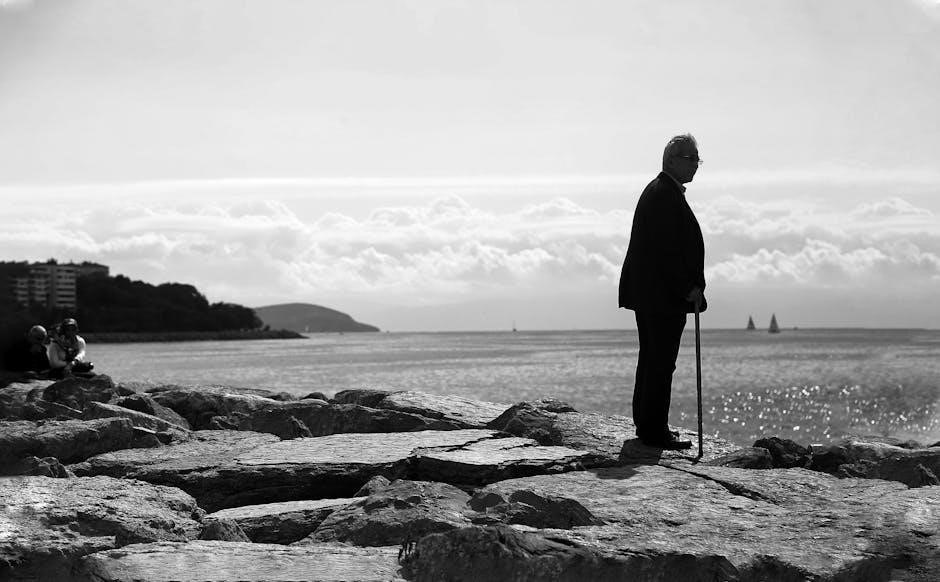The Old Man and the Sea, written by Ernest Hemingway, is a poignant tale of perseverance and human struggle against nature. The novella follows Santiago, an aging Cuban fisherman, who embarks on an epic journey to catch a giant marlin after 84 days of bad luck. This story, rich in symbolism and emotional depth, explores themes of determination, pride, and the inevitable confrontation with nature’s power.
Santiago’s voyage, marked by solitude and resilience, transcends a simple fishing tale, offering profound reflections on life’s challenges and the human spirit’s capacity to endure adversity.
Background and Historical Context
The Old Man and the Sea was written by Ernest Hemingway in 1952, during a period of personal and professional transformation. The novella is set in Cuba, near Havana, where Hemingway lived and drew inspiration from the local fishing community. The story reflects Hemingway’s deep connection to the sea, shaped by his experiences as a fisherman and big-game hunter in the Gulf Stream. Published after a decade of literary silence, the book revitalized Hemingway’s career and earned him the Pulitzer Prize in 1953. The novella’s maritime setting and themes of resilience resonate with Hemingway’s own life, including his love for the ocean and his fascination with human struggle. This context underscores the cultural and historical richness of the story, blending Cuban traditions with universal themes of perseverance.
Key Elements of the Novella
The Old Man and the Sea is a novella characterized by its simplicity, depth, and universal themes. At its core is the struggle between Santiago, an aging fisherman, and a colossal marlin, symbolizing humanity’s eternal battle with nature. The story unfolds in a sparse, coastal Cuban setting, where isolation and perseverance define Santiago’s existence. Central to the narrative are themes of determination, pride, and the human condition, intertwined with the symbolic representation of the marlin as both a challenge and a source of respect. Hemingway’s minimalist prose and the iceberg principle—where much of the meaning lies beneath the surface—enhance the novella’s emotional and philosophical impact. The relationship between Santiago and the young boy Manolin adds depth, exploring mentorship and the passage of wisdom. Together, these elements create a timeless tale of courage, loss, and the enduring spirit of the human soul.

Plot Summary
Santiago, an aging Cuban fisherman, embarks on a journey after 84 days without a catch. He battles a giant marlin, showcasing his determination and respect for nature’s power.
The Journey Begins
Santiago’s journey commences on the 85th day of his unlucky streak, driven by the promise to venture far into the Gulf Stream. Alone in his skiff, he navigates beyond the familiar coastal waters, reflecting on past successes and his bond with the natural world. The boy Manolin, who once fished with him, now watches from shore, embodying the connection between generations. Santiago’s determination to break his drought fuels his resolve, setting the stage for an encounter that will test his physical and emotional limits. The sea, vast and unpredictable, becomes both his adversary and his solace as he seeks redemption and purpose.
The Struggle with the Marlin
Santiago’s journey takes a dramatic turn when he hooks a colossal marlin, sparking an intense and prolonged battle. The marlin, a symbol of immense power, tests Santiago’s physical endurance and mental fortitude. For three grueling days, Santiago wrestles with the fish, enduring immense pain and exhaustion. Despite the marlin’s resistance, Santiago remains determined, fueled by a deep respect for his adversary and an unyielding will to conquer. The struggle becomes a metaphor for humanity’s eternal confrontation with nature, blending themes of pride, resilience, and the inevitable cycle of life and death. This epic clash underscores Santiago’s unwavering spirit, even as the outcome hangs precariously in the balance.
The Aftermath and Return
After the exhausting battle with the marlin, Santiago’s triumph is short-lived. As he begins his journey back to shore, a swarm of sharks, attracted by the marlin’s blood, descends upon the carcass, leaving only its skeleton by the time Santiago reaches land. Despite this devastating loss, Santiago feels a sense of pride and accomplishment, knowing he has proven his worth as a fisherman. The villagers, though unaware of the magnitude of his struggle, marvel at the giant marlin’s skeleton, which becomes a testament to Santiago’s enduring spirit. This poignant conclusion highlights the themes of perseverance, humility, and the inevitable cycle of victory and loss, leaving Santiago with a renewed sense of purpose and readiness for future challenges.

Characters
The novella centers around Santiago, an aging Cuban fisherman, and Manolin, a young boy who admires and assists him. Their bond highlights loyalty and intergenerational respect, while Santiago’s journey underscores his solitude and determination.
Santiago: The Old Fisherman
Santiago, the protagonist, is an aging Cuban fisherman who faces an extraordinary test of endurance and willpower. After enduring 84 days without a catch, he ventures into the Gulf Stream, determined to prove his worth despite his advanced age and solitude. His journey is not just about catching a fish but about confronting his own mortality and the vast, indifferent natural world. Santiago’s character embodies resilience, humility, and a deep connection with nature, which he respects and admires. His interactions with the marlin and the sharks reveal his profound understanding of life’s struggles and the inevitability of loss, yet he remains undeterred, symbolizing the human spirit’s capacity to persevere against overwhelming odds. His story is a testament to the enduring power of courage and determination in the face of adversity, making him one of literature’s most memorable and inspiring figures.
The Role of Manolin
Manolin, a young boy, plays a significant role in Santiago’s life, embodying loyalty, admiration, and compassion. Initially, he fishes alongside the old man but stops after 40 days due to his parents’ disapproval. Despite this, Manolin continues to support Santiago, showcasing a deep bond that transcends their generational gap. He brings Santiago food and bait, demonstrating unwavering loyalty. Manolin’s belief in Santiago’s abilities contrasts with the villagers’ skepticism, highlighting his faith in the old fisherman’s skills. Their relationship reflects a mentor-student dynamic, with Manolin learning valuable life lessons from Santiago. After Santiago’s return, Manolin vows to accompany him again, symbolizing the enduring connection between them. Manolin’s character adds emotional depth to the story, emphasizing themes of friendship and intergenerational respect amidst adversity.

Themes
Perseverance and determination shine as Santiago battles the marlin, reflecting his unyielding spirit. Pride vs. humility emerges through his journey, blending confidence with acceptance of nature’s power. Man vs. nature underscores the struggle between human will and the vast, indifferent sea, highlighting themes of resilience and existential reflection.
Perseverance and Determination
Perseverance and determination are central to Santiago’s character in The Old Man and the Sea. Despite an 84-day streak without catching fish, Santiago remains resolute, venturing far into the Gulf Stream to prove his worth. His journey symbolizes the human spirit’s capacity to endure adversity, even in the face of overwhelming odds. Santiago’s relentless pursuit of the marlin, despite physical pain and mental exhaustion, highlights his unwavering determination. This theme is reinforced by his refusal to surrender, even when the sharks destroy his prize catch. Santiago’s perseverance serves as a testament to the idea that true victory lies not in the outcome but in the courage to continue striving.
Pride vs. Humility
Pride and humility are deeply intertwined in Santiago’s journey. His pride as a fisherman drives him to venture far into the Gulf Stream, determined to prove his worth despite 84 days of bad luck. This pride is both a source of strength and a potential flaw, as it pushes him to take risks that others might avoid. However, Santiago’s humility shines through in his respect for nature and his acceptance of defeat. When the sharks destroy the marlin, he does not rail against fate but humbly acknowledges the cycle of life and death. Santiago’s balance of pride and humility underscores the novella’s message that true greatness lies not in external validation but in the quiet dignity of one’s efforts. His story teaches that pride, when tempered with humility, can lead to a deeper understanding of oneself and the world.
Man vs. Nature
The Old Man and the Sea profoundly explores the timeless conflict between humanity and nature. Santiago’s journey is a quintessential representation of this struggle, as he ventures into the vast, unpredictable Gulf Stream. The marlin he catches symbolizes the unyielding power of nature, while Santiago embodies human resilience and determination. Despite his physical limitations, he engages in a fierce battle with the marlin, showcasing the human spirit’s capacity to challenge the natural world. However, the novella ultimately highlights the inevitability of nature’s dominance, as the sharks devour the marlin, leaving Santiago with only a skeleton. This duality underscores the idea that while humans can strive against nature, they cannot fully conquer it. Santiago’s struggle, though un victorious in material terms, becomes a triumph of the human will to persevere.

Symbolism
The Old Man and the Sea is rich in symbolic elements. The marlin represents Santiago’s pride and struggle, while the sharks embody nature’s destructive power. Santiago’s journey symbolizes the human spirit’s perseverance against life’s challenges, blending triumph and tragedy in a universal narrative.
The Marlin as a Symbol
The marlin in The Old Man and the Sea is a powerful symbol, representing Santiago’s pride, determination, and the magnitude of his struggle. The giant fish embodies the ultimate challenge, pushing Santiago to his limits and testing his physical and emotional endurance. Its enormous size and beauty symbolize the unattainable perfection Santiago strives for, reflecting his inner quest for dignity and purpose. The marlin also represents the natural world’s indifference, as it fights fiercely but ultimately succumbs to Santiago’s will, only to be destroyed by sharks. This duality highlights the tragic beauty of Santiago’s journey, where victory and loss are intertwined, leaving a lasting impact on his spirit and the reader’s perception of human resilience.
The Sharks and Their Significance
The sharks in The Old Man and the Sea symbolize the destructive forces of nature and the inevitability of loss. After Santiago’s epic battle with the marlin, a swarm of sharks attacks and devours the fish, leaving only its skeleton. This event underscores the harsh reality that even the greatest achievements can be stripped away by uncontrollable elements; The sharks represent the natural world’s indifference to human effort, emphasizing that struggle and sacrifice, though noble, do not always yield lasting rewards. Their presence also highlights Santiago’s acceptance of fate, as he recognizes the marlin’s beauty and his own effort as sufficient, despite the ultimate loss. The sharks serve as a poignant reminder of life’s impermanence and the balance between triumph and tragedy. Their role deepens the novella’s exploration of human resilience and the cycle of nature.

Style and Technique
Hemingway’s concise, minimalist prose in The Old Man and the Sea creates a powerful, emotional narrative. His use of simple sentences and the Iceberg Principle adds depth, leaving much unsaid yet deeply felt.
Hemingway’s Writing Style
Ernest Hemingway’s writing style in The Old Man and the Sea is characterized by simplicity, clarity, and a focus on concrete, descriptive details. He employs short sentences and straightforward language, which creates a sense of directness and immediacy. This minimalist approach, known as the Iceberg Principle, allows readers to infer deeper meanings and emotions beneath the surface of the text. Hemingway’s prose is stripped of unnecessary embellishments, emphasizing action and dialogue over elaborate descriptions. This style not only reflects Santiago’s practical, no-nonsense demeanor but also enhances the novella’s emotional impact by allowing the reader to connect deeply with the old fisherman’s journey and struggles.
The Iceberg Principle

Ernest Hemingway’s The Old Man and the Sea exemplifies the Iceberg Principle, a writing technique where much of the story’s meaning lies beneath the surface. Hemingway’s sparse, concise prose leaves many details implied rather than explicitly stated, allowing readers to infer emotions, motivations, and deeper themes. This approach creates a sense of subtlety and depth, as the narrative suggests far more than it directly states. The principle is evident in Santiago’s internal reflections, the understated dialogue, and the symbolic elements woven into the story; By leaving much to the reader’s interpretation, Hemingway crafts a layered narrative that invites reflection and engagement, making the novella both powerful and enduring.

Context
The Old Man and the Sea is deeply rooted in Cuban culture and Hemingway’s personal experiences. Set near Havana, the novella reflects the simplicity of coastal life and the resilience of its people, drawing inspiration from Hemingway’s time in Cuba and his passion for fishing.
Cuban Setting and Culture
The novella is set in Cuba, near Havana, where Santiago, the aging fisherman, resides. The Cuban setting plays a crucial role in shaping the story’s themes and characters. The coastal village, with its vibrant culture and strong sense of community, provides a backdrop for Santiago’s journey. The novella reflects the daily struggles of Cuban fishermen, their deep connection to the sea, and their resilience in the face of adversity. Hemingway’s portrayal of the Cuban people and their way of life adds authenticity to the narrative, highlighting their respect for nature and their belief in perseverance. The cultural context also emphasizes the importance of tradition and the bond between the fisherman and the sea, which are central to the story’s emotional and symbolic depth.
Hemingway’s Life Influences
Ernest Hemingway’s personal experiences deeply influenced The Old Man and the Sea. His love for fishing and the sea, cultivated during his time in Cuba, is reflected in Santiago’s journey. Hemingway’s own struggles with fame and aging may have shaped Santiago’s character, emphasizing themes of perseverance and redemption. The novella also mirrors Hemingway’s admiration for Cuban culture and his respect for the resilience of its people. His unique writing style, characterized by simplicity and clarity, was honed through his journalistic background and his passion for storytelling. These elements combined to create a timeless tale that resonates with universal human experiences, drawing inspiration from Hemingway’s own life and observations of the world around him.

Impact and Legacy
The Old Man and the Sea has left a profound impact on literature and culture. Its themes of perseverance and human struggle resonate universally, inspiring countless adaptations and earning Hemingway the Pulitzer Prize. The novella solidified his reputation as a literary giant, influencing modern storytelling and remaining a timeless classic.
Cultural Impact
The Old Man and the Sea has had a profound cultural impact, resonating globally with its universal themes of perseverance and resilience. The novella’s simple yet powerful narrative has inspired numerous adaptations, including films, stage productions, and even ballets, ensuring its reach extends beyond literature. Its exploration of human struggle against nature has become a cultural metaphor, symbolizing the eternal quest for meaning and triumph over adversity. The story’s ability to transcend boundaries of language and culture has made it a beloved classic, shaping modern storytelling and influencing artists across genres. Hemingway’s work continues to inspire new generations, cementing its place as a cornerstone of 20th-century literature and a timeless reflection of the human spirit.
Literary Significance
The Old Man and the Sea holds immense literary significance as a landmark of modernist literature. Hemingway’s minimalist prose and the novella’s tightly knit structure have influenced countless writers, showcasing the power of simplicity and precision. The work’s exploration of universal themes—such as perseverance, pride, and humanity’s relationship with nature—has solidified its place in the literary canon. Its application of the Iceberg Principle, where deeper meanings lie beneath the surface, exemplifies Hemingway’s unique storytelling style. The novella’s brevity and depth have made it a subject of extensive critical analysis, highlighting its ability to convey profound truths through a deceptively simple narrative. This literary masterpiece remains a cornerstone of 20th-century fiction, continuing to inspire scholars and readers alike with its timeless appeal and artistic brilliance.

Adaptations
The Old Man and the Sea has been adapted into various forms of media, including films and stage productions, each capturing the essence of Hemingway’s timeless story.
Film Adaptations
The novella was notably adapted into a 1958 film starring Spencer Tracy, which remained faithful to the original narrative while bringing Santiago’s journey to life visually.
Stage Productions
Stage adaptations have also emerged, with theatrical interpretations emphasizing the emotional and philosophical depth of Santiago’s struggle, often using minimalist sets to reflect the story’s simplicity.
The Old Man and the Sea has been adapted into several films, each bringing Hemingway’s novella to life with visual and emotional depth. The most notable adaptation is the 1958 film starring Spencer Tracy, which faithfully captures Santiago’s journey and his epic battle with the marlin. Directed by John Sturges, the film emphasizes the old fisherman’s resilience and determination, earning critical acclaim for its loyalty to the original story. Another adaptation, a 1990 miniseries, features Anthony Quinn as Santiago, offering a more intimate portrayal of the character’s internal struggles. These films not only highlight the novella’s themes of perseverance and humanity but also provide a visual canvas for the timeless story of man versus nature.
Both adaptations remain celebrated for their ability to translate Hemingway’s concise prose into compelling visuals, ensuring the story’s enduring appeal across generations.
The Old Man and the Sea has been adapted into various stage productions, offering a unique interpretation of Hemingway’s novella. One notable production is a Kathakali-inspired adaptation, blending traditional Indian dance-drama with the story’s universal themes. This innovative approach brings Santiago’s journey to life through expressive movements and vibrant costumes, enriching the narrative with cultural depth.
Other stage adaptations have focused on minimalist designs, emphasizing Santiago’s solitude and his connection with nature. These productions often use narration and symbolic props to convey the emotional and physical struggles of the old fisherman. The stage adaptations not only honor Hemingway’s original work but also provide fresh perspectives, making the story accessible to diverse audiences and ensuring its timeless appeal continues to resonate.
The Old Man and the Sea remains a timeless tale of perseverance, resilience, and the human spirit’s struggle against nature. Santiago’s journey embodies universal lessons about courage and humility, ensuring its enduring relevance in modern times.
Relevance in Modern Times
The Old Man and the Sea continues to resonate deeply with modern audiences, offering timeless lessons on perseverance, self-respect, and the human condition. Santiago’s struggle mirrors contemporary challenges, such as facing failure and overcoming adversity, making the novella a universal and enduring allegory. The themes of resilience and humility are particularly relevant in today’s fast-paced, often isolating world, where individuals seek meaning and purpose. Hemingway’s concise prose and profound insights ensure that Santiago’s journey remains a powerful metaphor for life’s struggles and the enduring strength of the human spirit. The novella’s exploration of man vs. nature also raises important questions about our relationship with the environment, adding another layer of modern relevance.
Final Thoughts and Reflections
The Old Man and the Sea leaves readers with profound reflections on life, resilience, and the human spirit. Santiago’s journey embodies the struggle between ambition and humility, reminding us that true worth is found not in victory, but in the courage to persevere. Hemingway’s sparse prose amplifies the emotional depth, inviting readers to reflect on their own battles with adversity. The novella’s timeless appeal lies in its ability to transcend generations, offering universal lessons on dignity, grace, and the inevitability of loss. Santiago’s story becomes a metaphor for life itself, where the pursuit of meaning often outweighs the outcome. This enduring tale continues to resonate, proving that Hemingway’s work remains a cornerstone of literary excellence and human insight.